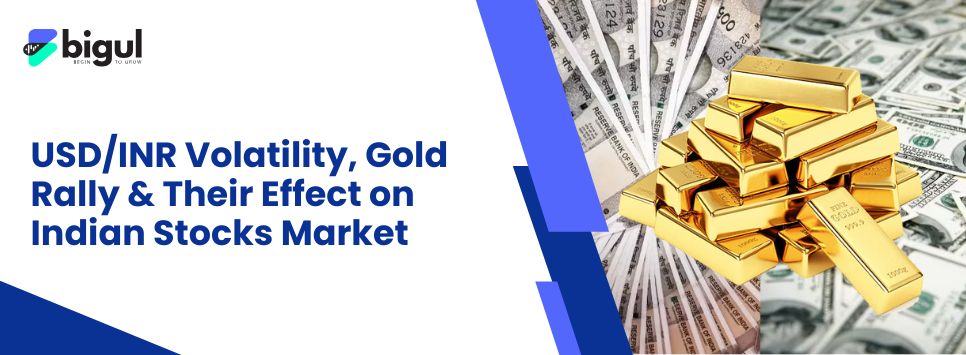Indian equities are impacted by a combination of currency weakness and increasing gold prices. As of today, the USD/INR parity is approximately 86.89, and the prices of gold have been moving upwards consistently. These are backed by global economic uncertainty, fear of inflation, and geopolitical tension. This article describes how all these factors influence different sectors of the Indian economy and what action the government and the RBI are taking to cope with these pressures.
Also Read | OMO, Modi-Trump Meeting, and Income Tax Bill Effect – Feb 13, 2025
1. Currency Dynamics: USD/INR Trends
Current Scenario: USD/INR Rate: About 86.89
Implications
· Exporters Gain
Weaker rupee reduces the price of Indian exports, making them cheaper in overseas markets. This is good for industries such as IT Services and Pharmaceuticals, as depreciating rupee increases their profit margins when converting foreign revenue.
· Importers Lose
Firms dependent on imported raw materials (e.g., Consumer Durables and Electronics) see increasing costs, which can squeeze their profit margins and impact stock prices.
· Foreign Investment
A strong USD at times causes capital outflows from emerging economies such as India. This can lower market liquidity and raise volatility. RBI interventions, however, can stabilize the rupee and offset these impacts.
Future Trends and Government Interventions
· Expected Trend
Global uncertainties and changes in US monetary policy can keep the USD strong and the INR volatile. This implies that the rupee could have sporadic bouts of weakness.
· Government and RBI Initiatives
Foreign Exchange Intervention: RBI aggressively sells dollars through state-owned banks to prop up the rupee.
· Liquidity Management
Recent open market operations (OMO) injecting ₹40,000 crore assist in lowering borrowing costs and stabilizing the financial system.
· Monetary Policy Shifts
Shifts in interest rates seek to balance economic growth and currency stability.
2. Gold Price Rally: Causes and Effects
Why Gold Prices Are Rising
· Safe-Haven Demand
During times of uncertainty in the world economy, investors seek refuge in gold as an asset of value.
· Inflation and Currency Woes
Weak interest rates and inflation concerns raise the appeal of gold relative to non-yielding instruments.
· Central Bank Action
More purchases of gold by central banks globally (including in the Asian region) underpin the price of gold as a hedging instrument.
How Rising Gold Prices Impact the Market
· Investor Conduct
When the prices of gold go up, certain investors reallocate their money out of equities into gold. This might cause temporary stock market volatility.
· Sector-Specific Effect
Exporters: Indirectly benefit since a depreciated rupee (which usually follows a high dollar) makes exports competitive.
Importers: Are under cost pressure if an increase in the price of gold is an indication of higher inflation.
Retail Impact: Gold is an important cultural symbol in India. Increased prices can lower jewelry buying, which can impact the FMCG industry.
3. Joint Impact on the Indian Stock Market
Market Sentiment and Economic Fundamentals
· Risk-Averse Positioning
With a strong USD and increasing gold prices, investors become risk-averse. This can result in lower equity exposure in cost-sensitive sectors.
· Sector Differentiation
Export-Oriented Sectors (e.g., IT, Pharmaceuticals): Most likely to gain from a weak rupee.
Import-Dependent Industries (e.g., Consumer Durables): Could experience profit margin squeeze.
Financials and Infrastructure: May gain from RBI liquidity interventions and reduced borrowing costs.
Long-Term Outlook: Sturdy domestic fundamentals, including healthy corporate earnings and supportive government policies, continue to support long-term growth, albeit if short-term volatility rises.
4. Future Trends & Management Strategies
Future Trend of USD/INR and Gold Volatility
· USD/INR
Most likely to be unstable in the backdrop of global uncertainties. RBI measures and policy moves will be imperative to avoid unwanted depreciation.
· Gold
Likely to sustain its rally as a safe-haven asset if global uncertainties and inflation pressures continue.
Government and RBI Actions
· To Contain USD/INR Volatility:
Foreign Exchange Interventions: Ongoing RBI interventions to calm the rupee.
Liquidity Measures: OMO operations to provide liquidity on a smooth flow basis.
Monetary Policy Adjustments: Targeted adjustments in interest rates to offset growth and inflation.
· To Address Gold Volatility
Encouraging Structured Investment: Fostering investments in regulated vehicles such as gold ETFs to moderate volatility in the market.
Watching Inflation: Adjusting policies to control inflation, which has an indirect impact on gold's safe-haven allure.
Conclusion & Strategic Recommendations
Overall Outlook
The interrelationship between a rising USD and escalating gold prices indicate a phase of market volatility. Export-based industries may gain with a depreciated rupee, whereas import-intensive industries might feel the pinch. Fiscal measures in the form of RBI interventions and subsequent fiscal decisions are designed to shore up the currency and stimulate market growth.
Recommendations
Diversification: Have an even portfolio balance across industries in order to diversify against currency and global economy risks.
Core Emphasis: Employ core metrics (PE, PEG, ROE) to pick stocks with high growth prospects.
Stay Updated: Monitor RBI policies, international economic trends, and central bank moves for timely portfolio rebalancing.

.jpg)






.jpg)
.jpg)
